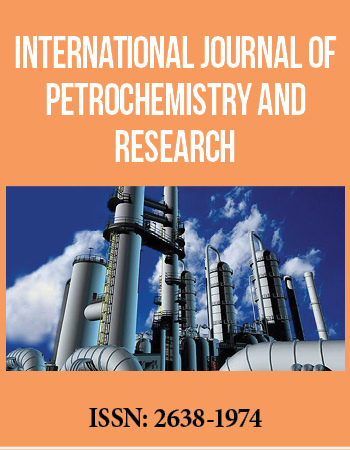Short Communication Article
Properties of Asphalt Binders with the Residue from Pyrolysis of Biomass as the Warm Mix Additive
1School of Chemical Engineering, Engineering Campus, UniversitiSains Malaysia, 14300 NibongTebal, SeberangPerai Selatan, Penang, Malaysia
2School of Civil Engineering, Engineering Campus, UniversitiSains Malaysia, 14300 NibongTebal, SeberangPerai Selatan, Penang, Malaysia
3Department of Civil Engineering, Ahar Branch, Islamic Azad University, Ahar, Iran
*Corresponding author: Tye Ching Thian, Associate Professor, School of Chemical Engineering, Universiti Sains Malaysia, 14300 Nibong Tebal, Seberang Perai Selatan, Penang, Malaysia, E-mail: chcttye@usm.my
Received: March 8, 2017 Accepted: March 16, 2017 Published: March 22, 2017
Citation: Tan CW, Tye CT, Hamzah MO, Golchin B. Properties of Asphalt Binders with the residue from pyrolysis of Biomass as the Warm Mix Additive. Int J Petrochem Res. 2017; 1(1): 1-5. doi: 10.18689/ijpr-1000101
Copyright: © 2017 The Author(s). This work is licensed under a Creative Commons Attribution 4.0 International License, which permits unrestricted use, distribution, and reproduction in any medium, provided the original work is properly cited.
Abstract
Asphalt is a complex mixture of hydrocarbons. Recently, a series of substances have
been used as an additive in order to change the asphalt's properties especially in the
road pavement engineering. This paper presents the properties changes of two asphalt
binders: AC 80/100 and SBS modified binders as the results of using residue from
pyrolysis of biomass as the warm mix additive. The resulted asphalt binders were
evaluated over a series of analyses including viscosity tests, dynamics shear rheological
tests, gel permeation chromatography and asphaltenes content analysis. Generally, it
could be concluded that residue from pyrolysis of biomass has a potential to be a warm
mix additive in term of viscosity reduction under certain conditions. It has also sufficient
Superpave rutting resistance at temperature as high as 64oC.
Keywords: Warm mix asphalt; biomass; asphaltene; viscosity.
Introduction
Hot mix asphalt was the most common and widely used technology in the pavement
construction. The mixing of aggregates and asphalt cement are normally carried out at
temperature higher than 150oC. Warm mix asphalt (WMA) technology is an innovation
developed with the aim of reducing the high temperature requirements for manufacturing
and laying of asphalt mixes [1]. WMA additive is a substance that is blended into the
asphalt binders or directly introduced into the asphalt plant's drum that improves the
process of manufacturing and paving asphalt by significantly reducing the temperatures
down to 40oC [1] [2] [3]. WMA helps to reach a more sustainable and less carbon intensive
processes and products.
Recently, significant attention has being given to new and innovative materials, which can act as WMA additive. For instance, Jamshidi et al. [4] evaluated the rheological
properties of unaged and aged asphalt binders incorporating various Sasobit and
Rediset contents at high and intermediate temperatures. Their results showed that
rheological properties of binders significantly depend on the binder source, additive
type and content. Later, an optimization method was used in selecting an appropriate
binder content, additive content and compaction temperature for fabrication of WMA
mixtures [5]. In 2016, Kakar et al. [6] evaluated the influence of a surfactant based warm
additive named Cecabase on the rheological properties of binders and mixtures. The
results showed that this additive has no effect on the binder rheology but it improves
the workability and compactibility of the asphalt mixtures. In another study, Gungat et al. [7] characterized the influence of a warm wax additive named RH-WMA on rhelogical properties of binders containing high amount of reclaimed
binders. Obtained results showed that this additive reduces
the viscosity of binders as well as improves the elasticity of the
binders. There were almost 20 WMA technologies being
marketed in the United States from 2005 to 2010 [8].These
WMA processes are generally categorized into three: foaming
process that uses water containing technology or water-based
technology, organic additives and chemical additives [1] [9]. All having the same goal, which is to reduce the binder
viscosity, to enhance the coating and workability of the mix, lower energy consumption and reduce emission [9]. Rubio et al. [1] have presented a detailed review of the WMA in 2012.
Organic additives such as Fischer-Tropsch wax, Montan
wax, and fatty acid amide wax with the trade name of
Asphaltan B, Sasobit and Licomont BS were extensively used
as WMA additives in laboratory studies [1]. In literatures, the
most common organic additive used is wax. Viscosities of
binders are reduced when wax is melted in the mix [3] [9]. One
of the important aspects of waxes is to be resistant at service
temperatures. Research which has done on the beneficial
effects of wax on asphalt showed that it is critically dependent
on the chemical structure of the waxes [10]. The length of
hydrocarbon in wax can affect the melting temperature of
waxes. Waxes that are selected to be used as WMA additives
are chosen based on their higher melting point above the
service temperature and their ability to mix with asphalt [10]. The waxes used are usually high molecular hydrocarbon
chains with a melting point about 80oC to 120oC and are able
to modify the virgin binder's properties [11].
This paper introduces a new chemical material, residue
from pyrolysis of biomass (RPB), which may have a potential
to be used as WMA additive. The residue is a condensed
volatile matter in the pyrolysis process of biomass for activated
carbon. RPB could be a suitable material to be used in asphalt
binder because of its low price and it is easy to obtain. Since
RPB is an organic based hydrocarbon as the wax, it could have
similar effects as the wax on asphalt binder. In this regard, the
effects of this material as an additive on different asphalt
binders were investigated. There was a series of analytical
tests on properties carried out in order to study the properties
changes of asphalt binders after adding different amounts of
RPB.
Experimental
WMA binder mixture preparation
Two types of asphalt binder were used in the present
study which were: Styrene-Butadiene-Styrene (SBS) asphalt
binder and asphalt cement according to penetration grade
80/100 (AC 80/100) provided by Shell Corp., Malaysia. The
additive used was residue from pyrolysis of biomass (RPB) for
activated carbon obtained from the relevant experiments in
lab. For binder mixture preparation, a Silverson L4RT blender
was used to blend the binder and additives. First, the SBS
binder was heated up to 180oC in an oven for 3 hours. Then, 200g of heated binder with the required amount of additive (1-3 wt%) were loaded into the blender's container which was
also preheated to 180oC. The blender's container together
with the heater was then placed under the high shear blender
propeller. A thermostat was also placed into the hot binder. The blending was done at 3000 rpm for 15 minutes to ensure
the additive has properly dissolved and formed a homogenous
phase with the binder. The similar sample preparation
procedure was followed when using AC80/100 as the asphalt
binder except the heating and operating temperature was
changed to 140oC.
Thermal analysis
Thermal analysis was performed using a Perkin Elmer
Thermal Analyzer, model STA 6000 under nitrogen (99.9995%) atmosphere, sample mass around 10 mg, with a constant
heating rate of 10oC/min, heated from room temperature to
600oC. The nitrogen flow during the experiments was 20 ml/
min. The mass versus temperature curves were used to
evaluate the thermal stability of binders respectively.
Asphaltenes Analysis
This analysis gives a measure of the percentage of
asphaltene content in the binder. The method was a typical
asphaltenes analysis test [12] for heavy oil. For each sample, 2g of liquid binder sample with 2ml of toluene (Reagent
grade, Fisher Scientific) was dissolved in a 100ml beaker. Then, the sample was mixed with 80 ml of n-pentane (Analytical
reagent grade, Fisher Scientific). The sample was kept in dark
and shaken for 5 minutes in every 30 minutes over a 2 hours
period. The precipitated formed was filtered through a
medium pore (10-15µm) Buchner filter funnel under slight
vacuum. The precipitate was washed with n-pentane and
dried in an oven at 110oC. The asphaltenes content was
calculated by the following equation:
Rotational viscometer (RV) test
One of the most important properties to be considered in
asphalt binder production is the viscosity of asphalt binder at
high temperature. It describes the ability to pump an asphalt
binder in a plant and the ability to coat the aggregates in
asphalt concrete binders before compacting into new
pavement surface [13]. A Model DV-II + rotational viscometer
by Brookfield Engineering Inc. was used for the viscosity
measurement of the binder with additive. The procedure used
was according to AASHTO T 316 (Standard Method of Test for
Viscosity Determination of Asphalt Binder Using Rotational
Viscometer).
Dynamic Shear Rheometer (DSR) test
DSR test was used to determine the complex modulus (G*) and phase angle (δ) of the asphalt binder. The performance
of asphalt binder was investigated in terms of rutting
resistance (G*/sin δ). The DSR test was performed by a Haake
Rheo Stress 6000 DSR Rheometer. The DSR test was carried
out according to the ASTM D7175 procedures.
Results and Discussion
Chemical properties of asphalt binders
AC80/100 binder is the most common type of asphalt
binder used in Malaysia for road construction [14]. Meanwhile, SBS polymer modified binder with improvement in terms of
rutting resistance, thermal cracking and fatigue damage [15], which is costly, is often used at the airport pavement. Elemental
analysis of AC 80/100 and SBS polymer modified binders
showed that the H/C ratio were 1.83 and 2.49, respectively. By
referring to Altgelt [16], typical H/C atomic ratio of bitumen
asphalt is usually between narrow ranges of 1.40-1.90. Therefore, the asphalt binders used were at the lighter end of
the range. The sulphur contents were 7.7 wt% and 4.7 wt% for
AC 80/100 and SBS polymer modified binders, respectively. Results were high as expected which is common for the asphalt. Therefore, it will benefit a lot especially in terms of sulphur
emission to the air if the mixing and working temperature of
the asphalt binder for pavement construction can be reduced.
Figure 1(a) shows the thermogravimetric curve for AC
80/100 binder. From the figure, the rate of weight loss starts
to be significant at temperature 385oC at 87.6 wt%. The weight
dropped quickly to a plateau at around 490oC and stayed
almost flat. This indicated that 87.6 wt% of AC 80/100 binder
is unstable at temperature higher than 385oC. Sample left is
remained constant at 20.6wt% between 490oC and 552oC. The
residue can be carbon residue as well as the materials with
much higher boiling point than 552oC.
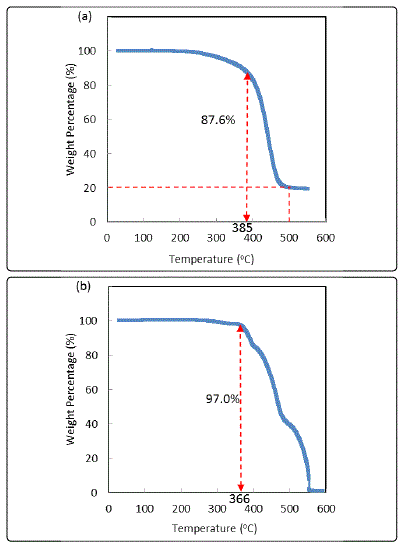
Figure 1: Thermogravimetric curve of (a) AC 80/100 binder and (b) SBS asphalt binder
From the thermogravimetric curve as shown in Figure 1(b), SBS asphalt binder was found to be thermally stable until a temperature of 366oC after which the weight started to drop significantly to almost zero at 550oC. Based on the graph, it indicates that this binder is slightly more thermally stable compared to AC 80/100 up to 366oC. Sample left was remained constant at 1.15wt% after 593oC. The residue left was mainly the carbon residue. The low level of carbon residue in SBS asphalt binder might be due to the added styrene-butadiene-styrene block copolymer, which modified the bonding within the molecules in asphalt which reduced the formation of carbon residue at high temperature. RPB was chosen as potential warm mix additive for this study. It is an organic based black liquid at room temperature. Based on the elemental analysis results, it contains carbon, nitrogen, hydrogen, sulphur and some other components, which warrant a further investigation.
Effects on the binders rheology properties
The viscosities of AC 80/100 and SBS binder with different amount of additive at various test temperatures are plotted in Figures 2(a) and 2(b), respectively. From these graphs, as expected, it is clear that viscosity decreases significantly as the test temperature increases. This is due to the effect of higher temperature to increase the average kinetic energy between the binder molecules. The viscosity of the AC 80/100 asphalt binders with additive reduces as concentration of additive increases. It means that higher concentration of additive (3%) improves the performance of this asphalt binder.
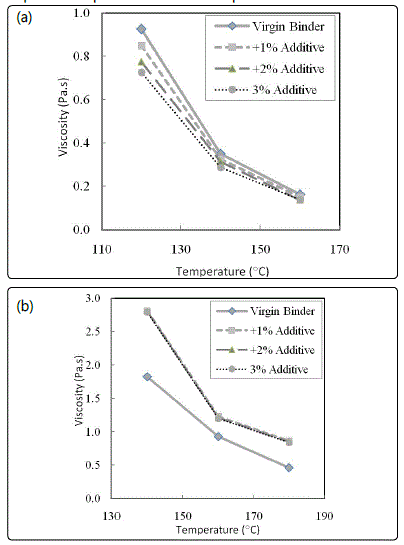
Figure 2: Viscosity of (a) AC 80/100 and (b) SBS binder with RPB additive at different temperatures.
Figure 2(a) also shows that, for AC 80/10 binder with
additive, viscosity reduction decreases with the temperature. The highest viscosity reduction was observed at 120oC. Then, viscosity reduction was found to decrease at 140oC compared
to that at 120oC. Basically, viscosity reduction was not significant
at 160oC. On the other hand, SBS asphalt binder with residue
additive showed an increase in viscosity after adding the
additives. This might be due to incompatibility between the
additive and the SBS asphalt binder. Addition of additive
molecules into SBS was likely to increase the internal friction
forces of the binder which caused the molecules to move less
freely and resulted an increase in the viscosity. Due to the
negative effects of the additives in SBS binder in terms of the
viscosity, which is the most important property that should be
reduced during the mixing, this binder had not been further
studied in the DSR test.
For asphalt pavements, rutting is one of the most serious
forms of pavement distress, and severe rutting is a cause of
pavement failure. DSR was used to evaluate the Superpave
rutting properties of AC 80/100 binder containing different
additive contents. Higher ratio value of Complex Modulus to
phase angle (G*/sin δ) indicates higher rutting resistance of
the asphalt binder. Figure 3 shows the G*/sin δ of asphalt
binder with 1%, 2% and 3% additive from 46oC to 82oC. From
the figure, asphalt binder rutting resistance reduces very little
when additive was blended into the asphalt binder. Increasing
additive content slowly increases G*/sin δ, while increasing
test temperature reduces G*/sin δ.
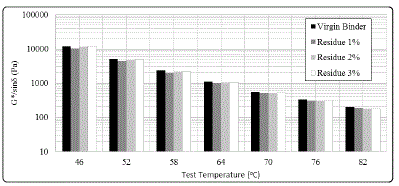
Figure 3: G*/sin δ of AC 80/100 binder containing 1%, 2% and 3% RPB additive.
Figure 4 shows the relationship between G* and phase angle (δ or delta) versus test temperature of AC 80/100 asphalt binder with and without additive. From the results, G* reduces when test temperature increases. Generally, there is no obvious influence of this additive on the G* and δ for the used binder.
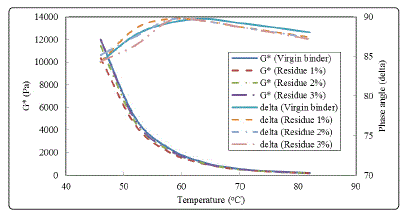
Figure 4: Relationship between G*, phase angle (delta) and test temperature of AC 80/100 binder with different amount of RPB additive.
Effects on asphaltenes content of the binders
Asphalt or heavy oil is generally constituted of oil, resin and
asphaltene. The two heavy and polar components of heavy oil
are asphaltenes and resin [17]. Asphaltenes are the highest
molecular weight compounds with aromatic rings structure, some side chains and carbon/hydrogen ratio less than 0.8 [18]. Asphaltenes influence the viscosity of heavy oil greatly but
resins reduce the influence of asphaltenes on viscosity [17]. From previous studies, it was reported that the chemical
structures, physicochemical properties and volume fraction of
asphaltenes are the main factors that influence the viscosity of
the heavy oil [19]. Viscosity of heavy oil increases with the
increase of asphaltenes content. This is due to the strong
aggregation of asphaltenes particles. Therefore, reduction of
asphaltenes content can be another alternative to reduce
viscosity of the binder.
Figure 5 shows the asphaltenes content of a series of
binders. By comparing the asphaltene contents between
AC80/100 binder and SBS binder, the asphaltenes content of
SBS binder (50.4%) was much higher than that of AC80/100
binder (27.8%). The result deduced directly that SBS has
higher viscosity at room temperature compared to AC 80/100. Therefore, higher temperature is needed during the mixing of
the SBS binder with aggregates. Nevertheless, there were only
little changes in the asphaltene content for AC 80/100 with
1-3% of RPB without a clear trend. On the other hand, for SBS
binder, asphaltenes content reduced little when additive
content increased from 1 to 3%. However, the viscosity of SBS
binder with RPB as additive did not reduce as expected.
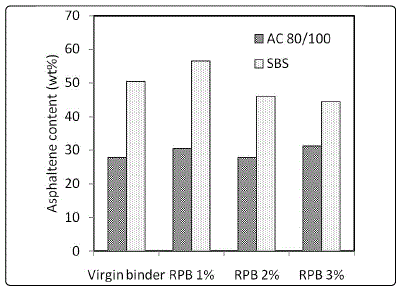
Figure 5: Asphaltenescontentof AC 80/100 and SBS binder containing RPB.
Gel Permeation Chromatography of the binders with RPB as additive were also carried out but the result was inconclusive (not shown) for the mix material. There were only slight reduction in the average molecular weights and the effect of the additive was not significant on the changes in distribution of values for large molecular sizes (LMS), medium molecular sizes (MMS) and small molecular sizes (SMS) [20]. According to Kim et al [8]., viscosity of asphalt binder is related to the amount of large molecular size molecules. However, the phenomenon was not observed here. Further investigation is necessary.
Conclusions
RPB, a liquid organic residue from pyrolysis was tested as a warm mix additive in asphalt binders. Its influences on the chemical and rheological properties of two conventional asphalt binders in Malaysia were investigated. Viscosity test, DSR, GPC and asphaltenes content analysis were carried out in this research. This additive showed an acceptable viscosity reduction for AC 80/100 binder and not for SBS binder. Meanwhile, the effect of RPB on reducing the viscosity of AC 80/100 at lower test temperature is higher when compared to higher test temperatures. The viscosity reduction was also found to increase with the additive concentration for AC 80/100 in the current study. RPB has not showed any negative effect on rutting resistance of binders. With the acceptable viscosity reduction and without negative effect on the rutting resistance, RPB was found a potential warm mix additive for AC 80/100 asphalt binder in Malaysia.
Acknowledgment
The authors acknowledge the Universiti Sains Malaysia Short Term Grant(304/60312033) for carried out the project.
References
- Rubio MC, Martinez G, Baena L, Moreno F. Warm Mix Asphalt: An Overview. Clean Prod J. 2012; 24: 76-84. doi: 10.1016/j.jclepro.2011.11.053
- Prowell BD, Hurley GC, Frank B. Warm Mix Asphalt: Best Practices. 3rd edition.Lanham, MD: National Asphalt Pavement Association; 2012.
- EAPA. The used of Warm Mix Asphalt. European Asphalt Pavement Association (EAPA). Accessed February20, 2017.
- Jamshidi A, Golchin B, Hamzah MO, Turner P. Selection of type of warm mix asphalt additive based on the rheological properties of asphalt binders.Clean Prod J. 2015; 100: 89-106. doi: 10.1016/j.jclepro.2015.03.036
- Hamzah MO, Teh SY, Golchin B, Voskuilen J. Use of imaging technique and direct tensile test to evaluate moisture damage properties of warm mix asphalt using response surface method. Construction and Building Materials. 2017; 132: 323-334. doi: 10.1016/j.conbuildmat.2016.11.092.
- Kakar M, Hamzah M, Valentin J, Hasan M. Mixture and rheological performance of asphalt binders blended with cecabase warm mix additive. 27th ARRB Conference, Melbourne, Victoria, Australia,2016.
- Gungat L, Yusoff NIM, Hamzah MO. Effects of RH-WMA additive on rheological properties of high amount reclaimed asphalt binders. Construction and Building Materials. 2016; 114: 665-672. doi: 10.1016/j. conbuildmat.2016.03.182.
- Kim Y, Lee J, Baek C, et al. Performance Evaluation of Warm-And Hot- Mix Asphalt Mixtures Based on Laboratory and Accelerated Pavement Tests. Advances in Materials Science and Engineering. 2012; 901658: 9. doi: 10.1155/2012/901658.
- Zaumanis M. Warm Mix Asphalt Investigation. PhD Thesis, Riga Technical University, Kgs. Lyngby, Denmark; 2010.
- Croteau JM, Tessier B. Warm mix asphalt paving technologies: A road builder's perspective. Paper presented at Annual Conference of the Transportation Association of Canada, Toronto, Ontario, 2008.
- Bueche N. Warm Asphalt Bituminous Mixtures with Regards To Energy, Emissions and Performance. Young Researchers Seminer (YRS) LAVOCCONF- 2010-002, Torino, Italy. 2009.
- Liu JK, Gunning HE. Syncrude Analytical Methods Manual for Bitumen Upgrading. Alberta oil Sands Technology and Research Authority, Edmonton, Alberta; 1991.
- Lee SJ, Amirkhanian SN, Park NW, Kim KW. Characterization of warm Mix Asphalt Binders Containing Artificially Long-Term Aged Binders. Construction and Building Materials. 2009; 23(6): 2371-79. doi: 10.1016/j. conbuildmat.2008.11.005.
- Yildirim Y. Polymer Modified Asphalt Binders. Construction and Building Materials. 2007; 21(1): 66-72. doi: 10.1016/j.conbuildmat.2005.07.007.
- Tia M. Fundamentals And Practice Of Asphalt Mixture Design Procedures To Assure Adequate Performance. 13th conference on pavement engineering, Hsin Chu, Taiwan, 2005.
- Altgelt KH. Composition and Analysis of Heavy Petroleum Fractions. New York, NY: Marcel Dekker; 1993: 129-132.
- Pierre C, Barré L, Pina A, Moan M. Composition and Heavy Oil Rheology. Oil & Gas Science and Technology. 2004; 59(5): 489-501. doi: 10.2516/ ogst:2004034.
- Wei J, Shull JC, Hawley MC, Barak J. Characterization of Asphalt Binders Based on Chemical and Physical Properties. International GPC symposium '94, 95-0365. 1994: 729-756.
- Luo P, Gu Y. Effects of asphaltene Content on the Heavy Oil Viscosity at Different Temperatures. Fuel. Elsevier J. 2007; 86(7-8): 1069-1078. doi: 10.1016/j.fuel.2006.10.017.
- Ragab M, Abdelrahman M. Investigation of the Physical and Molecular Properties of Asphalt Binders Processed with Used Motor Oils. Journal of Materials. 2015; 632534: 9. doi: 10.1155/2015/632534.

